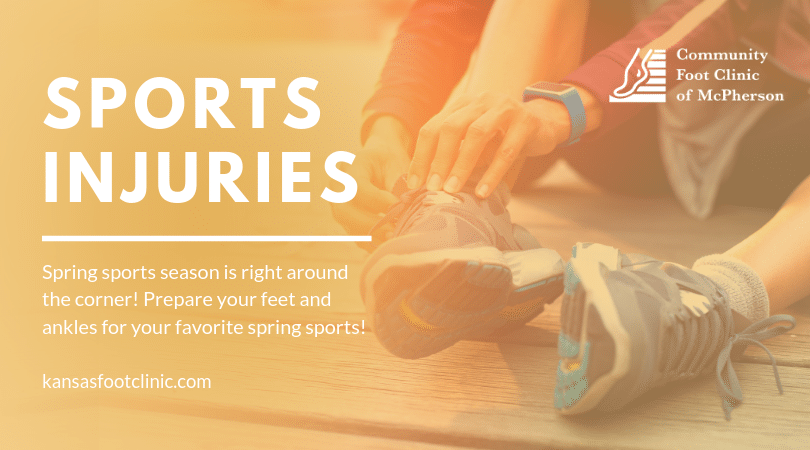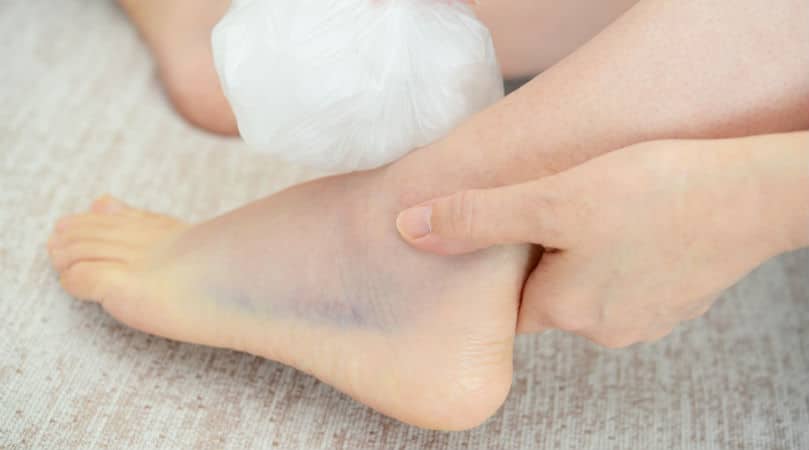Seasonal Sports Injuries
Is winter over yet?!
For some of us, the snowy season can never be over soon enough. The heavy jackets, the endless shoveling, and the inevitable hibernation can take a toll on our bodies and minds. Thankfully the uplifting spring season is finally peeking around the corner and with the warmer weather you may be getting that itch to get back out there in the courts and fields.
Here at Community Foot Clinic of McPherson we know athletes are passionate about their bodies, their sport, and their team. This passion pushes you to live healthy and active lives – and that is great! We encourage our patients to be active but unfortunately, the constant impact, the twists, the turns, and the landings your feet and ankles experience as you charge towards your goal can also lead to injury.
And, whether you are an athlete or not, your feet and ankles are an important part of your life! They help you stand, walk, run, shift, turn and everything in between. So, if you are planning on shooting some hoops or just want to start your running routine again, taking care of your feet and ankles should be top priority on your to-do list.
The good news is that we offer a variety of advanced treatment methods aimed to get athletes like you back in the game as quickly and as safely as possible.
Keep reading our blog to find out how to best prepare your feet and ankles from common sports injuries.
Shin Splints
If you love to run, then you probably have experienced sore lower legs. Maybe this condition started after you had been running for a few miles and suddenly you find yourself having to ice your shins in order to subside the discomfort every time you take your morning jogs.
Well, you aren’t the only one – many athletes also struggle with aching lower legs, especially after completing intensive practice. But just because this condition affects many different people, doesn’t mean you should take this pain lightly or dismiss it as “normal.”
Pain in the shins – also known as shin splints – is never normal! And, when left untreated, shin splints can become a bigger problem in the future.
So, whenever your lower legs start giving you grief, take these simple steps:
- Rest your legs. The problem will not improve if you continue to strain the tissues in your feet.
- Avoid high-impact movements. Instead, opt for low-impact sports like swimming or biking.
- Ice the area. This will reduce swelling and irritation in the affected tissues.
- Compress your shins. Use compressing socks or wrap bandages to prevent swelling.
- Change your shoes or invest in orthotics. This will give you better support and cushion for your feet.
Finally, once your legs no longer ache and you confirm with a medical professional that you are eligible to safely get back in the game, then you can gradually return to your activities and start conditioning your shins to handle the stress.
Ankle Sprains
Ankle sprains happen whenever your foot twists or rotates suddenly and at an awkward angle. This sudden movement causes the connective tissues which hold the joint together to stretch beyond their range of motion. The usual symptoms are: sharp, sudden pain followed by weakness, trouble bearing weight or moving your ankle around, swelling and bruising.
Most ankle sprains are relatively moderate, causing minimal pain. But in severe cases, these connective tissues may tear, so that walking and standing can become very difficult or painful. And, if you routinely put a lot of stress on your ankles during sports activities like basketball and track, those sudden starts, stops, twists, turns, and jumps can easily inflict an ankle sprain ranging from moderate to severe.
Nonetheless, regardless of the degree of pain and damage, you should immediately seek medical treatment whenever you suspect you have suffered an ankle sprain — without proper care, the tissues will continue to be strained and may even heal incorrectly, leading to chronic conditions.
Here are some things you should do right away if you suspect you have an ankle sprain:
- Rest your ankle. If the condition is mild, simply take a break from your routine sports activities. If the injury is more serious, then you may need to avoid putting weight on the sprained joint.
- Ice the area. You can also use anti-inflammatory medications to help reduce any potential swelling and to relieve pain.
- Use a wrap or brace. This will help both compress and stabilize the joint.
- Check with your doctor. You should also have the affected area checked for any potential fractures or tears as these may require more intensive treatments.
In some rare cases, ankle sprains may require surgery to completely repair the damaged tissues. And, if that is your situation, there is no need to worry! We will examine the injured ankle and use treatments tailored to your specific needs.
Heel Pain (Plantar fasciitis)
Every year, athletes from around the globe suffer from a common foot problem simply known as heel pain. Heel pain is usually attributed to a condition called plantar fasciitis which can limit your mobility and restrict your sports activities.
Plantar fasciitis essentially causes inflammation and pain in the tissue that connects your heel to your toes. You may be experiencing pain in the bottom of your heel when you first get out of bed, or when you first stand after sitting for long periods, or after participating in an activity. And, although initially the pain may be bearable, it can gradually become worse. In fact, most heel pain conditions get worse the longer they are left untreated.
If your heels are giving your grief, then here are some things you can do to ease your discomfort:
- Rest your heels. Cease all your routine sports activities until the pain subsides.
- Use an ice pack. This will help reduce swelling, inflammation, and pain.
- Take an over-the-counter pain reliever. Ibuprofen or acetaminophen should do the trick.
- Do some stretching. Before any activity, perform some foot flexing and stretches.
- Adjust your shoes. Complement your appropriate footwear with orthotics to help raise the heel and support the arch of your foot.
These are some ways in which you can help prevent and treat minor sports injuries while you are out there charging through the court or running through the track field. And, we certainly hope that these tips will help you enjoy a fun and safe spring sports season without experiencing any of these injuries.
Contact Us Today!
However, we understand that whenever we are active, the chances of developing painful conditions and suffering sports injuries naturally increase. So, if you do develop pain and discomfort in your feet or ankles, come see us at Community Foot Clinic of McPherson.
Our team will provide you with the most effective sports injury care available, including advanced options like MLS laser therapy for those of you who need to get back in the game as quickly as possible.
To schedule an appointment at one of our three convenient locations – McPherson, Herington, or Hillsboro – just give us a call today at (620) 241-3313 or simply fill out our contact form online.
© Community Foot Clinic of McPherson. All Rights Reserved.
Privacy Policy | Terms & Conditions
Web Design by CP Solutions
Marketed by VMD Services


